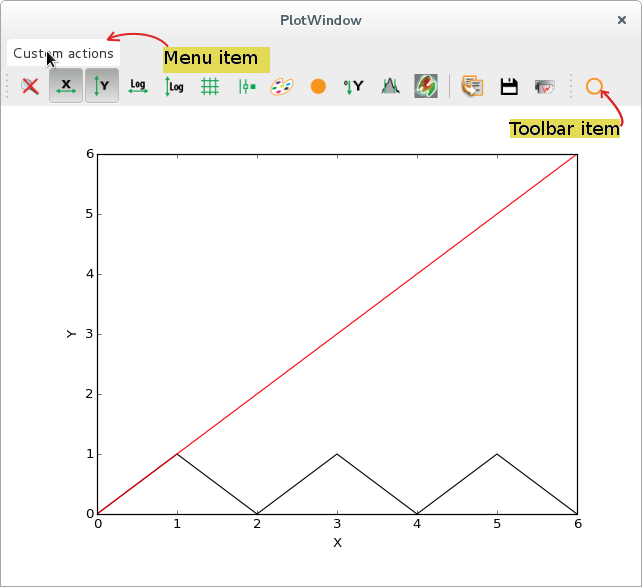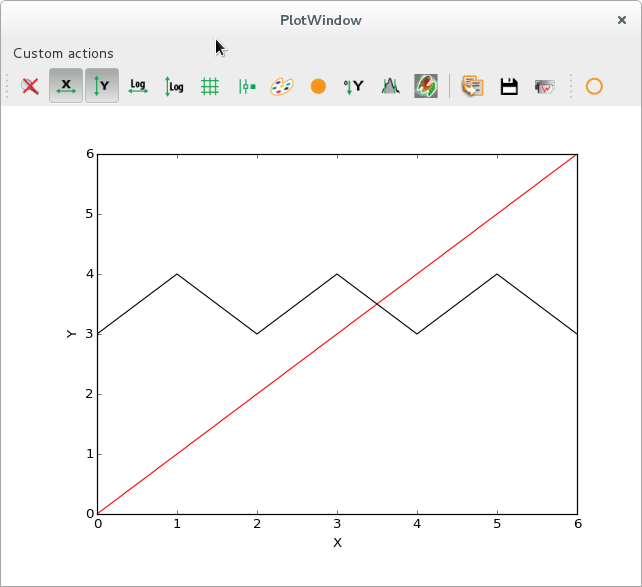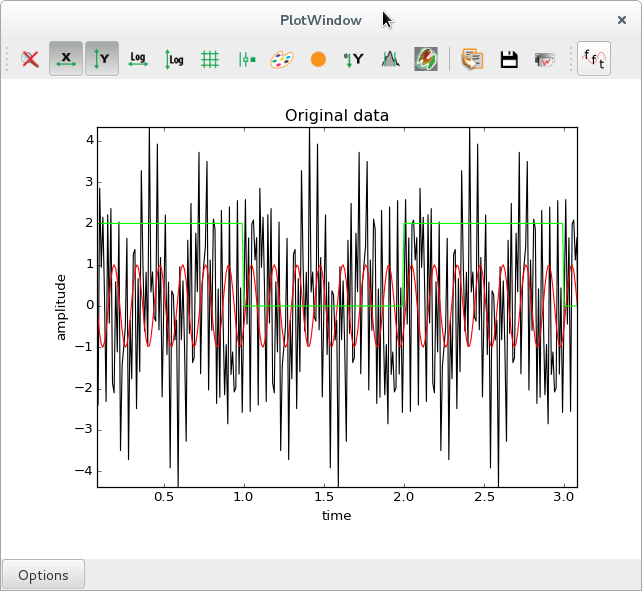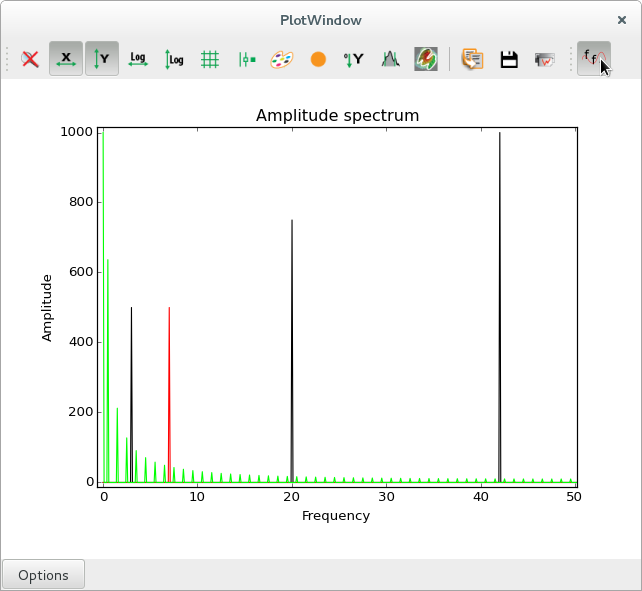Adding custom plot actions¶
A PlotWindow defines a number of standard plot actions that can be executed by clicking on toolbar icons.
Developers can design additional plot actions to be added as toolbar icons or as menu entries, to be added to a PlotWindow or to design their own plot window based on PlotWidget.
This documentation pages provides examples on how to do this.
Simple example: Shift a curve¶
The following script is a simplistic example to show the basic required steps:
- create a new class inheriting from silx.gui.plot.PlotActions.PlotAction
- define basic parameters such as the icon, the tooltip...
- write a method that will be triggered by the action
- initialize the new plot action by passing a reference to a plot window
- add the action to a toolbar or a menu
The method implemented in this action interacts with the plot in a basic way. It gets the active curve, then it creates a new data array based on the curve data, and finally it replaces the original curve with a new one using the modified data array.
from silx.gui import qt
from silx.gui.plot import PlotWindow
from silx.gui.plot.PlotActions import PlotAction
class ShiftUpAction(PlotAction):
"""QAction shifting up a curve by one unit
:param plot: :class:`.PlotWidget` instance on which to operate
:param parent: See :class:`QAction`
"""
def __init__(self, plot, parent=None):
PlotAction.__init__(self,
plot,
icon='shape-circle',
text='Shift up',
tooltip='Shift active curve up by one unit',
triggered=self.shiftActiveCurveUp,
parent=parent)
def shiftActiveCurveUp(self):
"""Get the active curve, add 1 to all y values, use this new y
array to replace the original curve"""
# By inheriting from PlotAction, we get access to attribute self.plot
# which is a reference to the PlotWindow
activeCurve = self.plot.getActiveCurve()
if activeCurve is not None:
# Unpack curve data.
# Each curve is represented by a tuple of 5 variables:
# - x and y are the array of abscissa and ordinate values
# - legend is a unique text identifying a curve
# - info and params are dictionaries of additional data
# (user defined, curve style and color...)
x0, y0, legend, info, _params = activeCurve
# Add 1 to all values in the y array
# and assign the result to a new array y1
# (do not modify y0 if you want to preserve the original curve)
y1 = y0 + 1.0
# Re-using the same legend causes the original curve
# to be replaced
self.plot.addCurve(x0, y1, legend=legend,
info=info)
# creating QApplication is mandatory in order to use qt widget
app = qt.QApplication([])
sys.excepthook = qt.exceptionHandler
# create a PlotWindow
plotwin = PlotWindow()
# Add a new toolbar
toolbar = qt.QToolBar("My toolbar")
plotwin.addToolBar(toolbar)
# Get a reference to the PlotWindow's menu bar, add a menu
menubar = plotwin.menuBar()
actions_menu = menubar.addMenu("Custom actions")
# Initialize our action, give it plotwin as a parameter
myaction = ShiftUpAction(plotwin)
# Add action to the menubar and toolbar
toolbar.addAction(myaction)
actions_menu.addAction(myaction)
# Plot a couple of curves with synthetic data
x = [0, 1, 2, 3, 4, 5, 6]
y1 = [0, 1, 0, 1, 0, 1, 0]
y2 = [0, 1, 2, 3, 4, 5, 6]
plotwin.addCurve(x, y1, legend="triangle shaped curve")
plotwin.addCurve(x, y2, legend="oblique line")
plotwin.show()
app.exec_()
 |
Initial state |
 |
After triggering the action 3 times, the selected triangle shaped curve is shifted up by 3 units |
Advanced example: Display amplitude spectrum¶
This more advanced example shows additional ways of interacting with the plot, by changing labels, storing additional data array along with the curve data.
This action is checkable, meaning that is has two states. When clicking the toolbar icon or the menu item, it remains in a pushed state until it is clicked again.
In one state (un-checked), the original data is displayed. In the other state, the amplitude spectrum of the original signal is displayed. When the state is changed, the triggered action computes either the Fast Fourier Transform (FFT), or the reverse FFT.
This example also illustrates how to store additional data, along with a curve. The FFT computation returns complex values, but we want to display real data, so we compute the amplitude spectrum. However, the inverse FFT requires the complete FFT data as input. We are therefore required to store the complex array of FFT data as curve metadata, in order to be able to reverse the process when the action is unchecked.
import numpy
import os
import sys
from silx.gui import qt
from silx.gui.plot import PlotWindow
from silx.gui.plot.PlotActions import PlotAction
# Custom icon
# make sure there is a "fft.png" file saved in the same folder as this script
scriptdir = os.path.dirname(os.path.realpath(__file__))
my_icon = os.path.join(scriptdir, "fft.png")
class FftAction(PlotAction):
"""QAction performing a Fourier transform on all curves when checked,
and reverse transform when unchecked.
:param plot: PlotWindow on which to operate
:param parent: See documentation of :class:`QAction`
"""
def __init__(self, plot, parent=None):
PlotAction.__init__(
self,
plot,
icon=qt.QIcon(my_icon),
text='FFT',
tooltip='Perform Fast Fourier Transform on all curves',
triggered=self.fftAllCurves,
checkable=True,
parent=parent)
def _rememberGraphLabels(self):
"""Store labels and title as attributes"""
self.original_title = self.plot.getGraphTitle()
self.original_xlabel = self.plot.getGraphXLabel()
self.original_ylabel = self.plot.getGraphYLabel()
def fftAllCurves(self, checked=False):
"""Get all curves from our PlotWindow, compute the amplitude spectrum
using a Fast Fourier Transform, replace all curves with their
amplitude spectra.
When un-checking the button, do the reverse transform.
:param checked: Boolean parameter signaling whether the action
has been checked or unchecked.
"""
allCurves = self.plot.getAllCurves(withhidden=True)
if checked:
# remember original labels
self._rememberGraphLabels()
# change them
self.plot.setGraphTitle("Amplitude spectrum")
self.plot.setGraphXLabel("Frequency")
self.plot.setGraphYLabel("Amplitude")
else:
# restore original labels
self.plot.setGraphTitle(self.original_title)
self.plot.setGraphXLabel(self.original_xlabel)
self.plot.setGraphYLabel(self.original_ylabel)
self.plot.clearCurves()
for curve in allCurves:
x, y, legend, info, _params = curve
if checked:
# FAST FOURIER TRANSFORM
fft_y = numpy.fft.fft(y)
# amplitude spectrum
A = numpy.abs(fft_y)
# sampling frequency (samples per X unit)
Fs = len(x) / (max(x) - min(x))
# frequency array (abscissa of new curve)
F = [k * Fs / len(x) for k in range(len(A))]
# we need to store the complete transform (complex data) to be
# able to perform the reverse transform.
info["complex fft"] = fft_y
info["original x"] = x
# plot the amplitude spectrum
self.plot.addCurve(F, A, legend="FFT of " + legend,
info=info)
else:
# INVERSE FFT
fft_y = info["complex fft"]
# we keep only the real part because we know the imaginary
# part is 0 (our original data was real numbers)
y1 = numpy.real(numpy.fft.ifft(fft_y))
# recover original info
x1 = info["original x"]
legend1 = legend[7:] # remove "FFT of "
# remove restored data from info dict
for key in ["complex fft", "original x"]:
del info[key]
# plot the original data
self.plot.addCurve(x1, y1, legend=legend1,
info=info)
self.plot.resetZoom()
app = qt.QApplication([])
sys.excepthook = qt.exceptionHandler
plotwin = PlotWindow(control=True)
toolbar = qt.QToolBar("My toolbar")
plotwin.addToolBar(toolbar)
myaction = FftAction(plotwin)
toolbar.addAction(myaction)
# x range: 0 -- 10 (1000 points)
x = numpy.arange(1000) * 0.01
twopi = 2 * numpy.pi
# Sum of sine functions with frequencies 3, 20 and 42 Hz
y1 = numpy.sin(twopi * 3 * x) + 1.5 * numpy.sin(twopi * 20 * x) + 2 * numpy.sin(twopi * 42 * x)
# Cosine with frequency 7 Hz and phase pi / 3
y2 = numpy.cos(twopi * 7 * (x - numpy.pi / 3))
# 5 periods of square wave, amplitude 2
y3 = numpy.zeros_like(x)
for i in [0, 2, 4, 6, 8]:
y3[i * len(x) / 10:(i + 1) * len(x) / 10] = 2
plotwin.addCurve(x, y1, legend="sin")
plotwin.addCurve(x, y2, legend="cos")
plotwin.addCurve(x, y3, legend="square wave")
plotwin.setGraphTitle("Original data")
plotwin.setGraphYLabel("amplitude")
plotwin.setGraphXLabel("time")
plotwin.show()
app.exec_()
sys.excepthook = sys.__excepthook__


